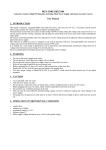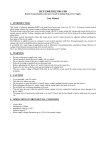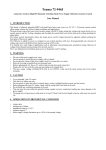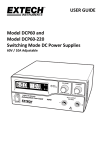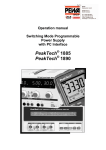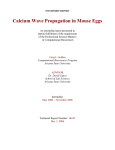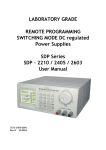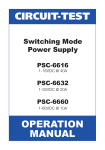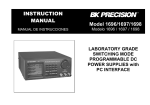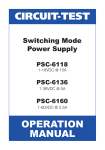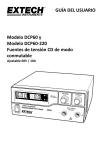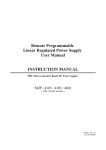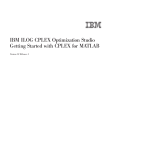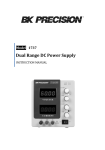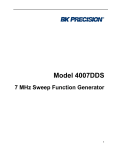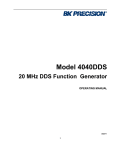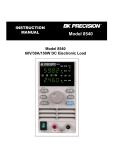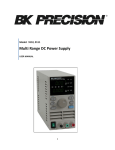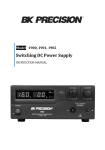Download B&K Precision 1685B 1687B 1688B Switching DC Power Supplies
Transcript
Model 1685B, 1687B, 1688B
Switching DC Power Supply
INSTRUCTION MANUAL
1
Safety Summary
The following safety precautions apply to both operating and maintenance personnel and
must be observed during all phases of operation, service, and repair of this instrument. Before
applying power, follow the installation instructions and become familiar with the operating
instructions for this instrument.
GROUND THE INSTRUMENT
To minimize shock hazard, the instrument chassis and cabinet must be connected to
an electrical ground. This instrument is grounded through the ground conductor of
the supplied, three-conductor ac power cable. The power cable must be plugged
into an approved three-conductor electrical outlet. Do not alter the ground
connection. Without the protective ground connection, all accessible conductive
parts (including control knobs) can render an electric shock. The power jack and
mating plug of the power cable meet IEC safety standards.
DO NOT OPERATE IN AN EXPLOSIVE ATMOSPHERE
Do not operate the instrument in the presence of flammable gases or fumes.
Operation of any electrical instrument in such an environment constitutes a definite
safety hazard.
KEEP AWAY FROM LIVE CIRCUITS
Instrument covers must not be removed by operating personnel. Component
replacement and internal adjustments must be made by qualified maintenance
personnel. Disconnect the power cord before removing the instrument covers and
replacing components. Under certain conditions, even with the power cable
removed, dangerous voltages may exist. To avoid injuries, always disconnect power
and discharge circuits before touching them.
DO NOT SERVICE OR ADJUST ALONE
Do not attempt any internal service or adjustment unless another person, capable of
rendering first aid and resuscitation, is present.
DO NOT SUBSTITUTE PARTS OR MODIFY THE INSTRUMENT
Do not install substitute parts or perform any unauthorized modifications to this
instrument. Return the instrument to B&K Precision for service and repair to ensure
that safety features are maintained.
1
WARNINGS AND CAUTIONS
WARNING and CAUTION statements, such as the following examples, denote a
hazard and appear throughout this manual. Follow all instructions contained in
these statements.
A WARNING statement calls attention to an operating procedure, practice, or
condition, which, if not followed correctly, could result in injury or death to
personnel.
A CAUTION statement calls attention to an operating procedure, practice, or
condition, which, if not followed correctly, could result in damage to or destruction
of parts or the entire product.
WARNING:
Do not alter the ground connection. Without the protective ground
connection, all accessible conductive parts (including control knobs)
can render an electric shock. The power jack and mating plug of the
power cable meet IEC safety standards.
WARNING:
To avoid electrical shock hazard, disconnect power cord before
removing covers. Refer servicing to qualified personnel.
CAUTION:
Before connecting the line cord to the AC mains, check the rear panel
AC line voltage indicator. Applying a line voltage other than the
indicated voltage can destroy the AC line fuses. For continued fire
protection, replace fuses only with those of the specified voltage and
current ratings.
CAUTION:
This product uses components which can be damaged by electrostatic discharge (ESD). To avoid damage, be sure to follow proper
procedures for handling, storing and transporting parts and
subassemblies which contain ESD-sensitive components.
SAFETY SYMBOLS
This symbol on an instrument indicates that the user should refer to the
operating instructions located in the manual.
Certification
We certify that this product met its published specifications at time of shipment from the
factory.
2
Compliance Statements
Disposal of Old Electrical & Electronic Equipment (Applicable in the European Union and
other European countries with separate collection systems)
This product is subject to Directive 2002/96/EC of the European
Parliament and the Council of the European Union on waste
electrical and electronic equipment (WEEE), and in jurisdictions
adopting that Directive, is marked as being put on the market
after August 13, 2005, and should not be disposed of as
unsorted municipal waste. Please utilize your local WEEE
collection facilities in the disposition of this product and
otherwise observe all applicable requirements.
3
Contents
1
Safety Summary ........................................................................................ 1
2
Introduction .............................................................................................. 6
3
Controls and Indicators ............................................................................. 7
4
3.1
Front Panel ........................................................................................ 7
3.2
Rear Panel ......................................................................................... 8
Operating Instructions .............................................................................. 9
4.1
4.1.1
Connection .............................................................................. 10
4.1.2
Self Test Sequence .................................................................. 10
4.1.3
Control Knobs.......................................................................... 12
4.1.4
Using Both Main and Auxiliary Outputs .................................. 13
4.2
5
Using the Power Supply .................................................................. 10
Control Modes ................................................................................ 13
4.2.1
Normal Mode .......................................................................... 14
4.2.2
Preset Mode ............................................................................ 14
4.2.3
Set Mode ................................................................................. 15
4.2.4
Analog Remote Control Mode ................................................ 16
Remote Control....................................................................................... 16
5.1
Analog Remote Control ................................................................... 16
5.1.1
Using Two External Variable DC Voltage Sources ................... 18
4
5.1.2
Using Two 5 kΩ Variable Resistors.......................................... 19
5.1.3
Enable and Disable the Output ............................................... 20
5.2
6
PC Interface Control ........................................................................ 21
5.2.1
General Functions and Display................................................ 21
5.2.2
External Timed Program ......................................................... 22
5.2.3
Internal Preset Memory .......................................................... 23
5.2.4
Data Log .................................................................................. 24
5.2.5
Settings.................................................................................... 26
5.2.6
Command Set .......................................................................... 26
Faults and Troubleshooting .................................................................... 31
6.1
OVP: Overvoltage Protection ......................................................... 31
6.2
OTP: Overtemperature Protection................................................. 31
6.3
OLP: Overload Protection............................................................... 32
6.4
Fuse Replacement ........................................................................... 33
7
Specifications .......................................................................................... 34
8
Certification ............................................................................................ 36
9
Service Information ................................................................................ 37
10
Limited Two-Year Warranty .................................................................... 38
5
2
Introduction
B&K Precision models 1685B, 1687B, and 1688B are laboratory grade switching mode
DC power supplies with high current output in a small form factor and lightweight
package. The 1685B Series provides various configurations of output voltage and
current, and make setting voltage and current levels fast and precise through its dual
action, coarse/fine rotary encoder control knobs. In addition to its constant voltage
(CV) and constant current (CC) modes, the high efficiency DC power supply offers a
unique solution with its preset and analog remote control modes. Save up to three
different presets of voltage and current values for quick recall. The analog remote
control function allows the output power, voltage, and current to be adjusted
without touching the front panel of the power supply. These features make the
1685B Series suitable for a wide range of applications including production testing,
telecommunications, R&D, service, and university labs.
Features
• Automatic CV/CC crossover operation
• Lightweight and compact
• Rotary encoder control for precise voltage and current setting
• Save up to 3 user-defined voltage and current presets for quick recall
• PC software for remote control and external timed programming
• Analog remote control function
• USB interface
• Front panel auxiliary output
• Overvoltage, overtemperature, and overload protection
6
3
Controls and Indicators
3.1
Front Panel
Figure 1 - Front Panel
(1)
LED panel meter display with CV/CC indicator
(2)
Rear Control Indicator (lights up when using Preset/Remote Control/Set mode)
(3)
Output Voltage Control Knob (control main and auxiliary output voltage)
(4)
Output Current Control Knob (control main and auxiliary output current limit)
(5)
Power ON/OFF Switch
(6)
Auxiliary Output Terminal (max 5 A)
Note:
Please see Section 4.1.4 for more details on using both main and
auxiliary output terminals together.
7
3.2
Rear Panel
Figure 2 - Rear Panel
(7)
Main Output Terminal (max 5 A for 1685B / 10 A for 1687B / 20 A for 1688B)
Note:
Please see Section 4.1.4 for more details on using both main and
auxiliary output terminals together.
(8)
Mode Selection Switch (Normal, Preset, Remote Control, Set Modes)
(9)
Recall Preset Selection Switch
(10)
Analog Remote Control Terminal
(11)
Cooling Fan Air Intake Grille
(12)
AC Input Plug and Fuse Compartment
(13)
USB Port (for PC remote control)
8
4
Operating Instructions
Safety Precautions
●
This power supply is for indoor use only.
●
Do not expose the power supply to sun, high humidity, or dusty
environments.
●
Never remove the metal cover of the power supply while AC power is
connected.
●
Never touch the unit when your hands are wet.
●
Never block the ventilation slots and cooling fan air intake window.
●
Never attempt to repair the power supply. Incorrect re-assembly may
result in a risk of electric shock or fire.
●
Never use the power supply for a load requiring higher current than the
designed value. Otherwise it may damage the power supply.
●
Place the power supply on a flat surface with sufficient clearance and dry,
dust-free surroundings for ventilation.
This series has three models with different output voltage and current ranges. Make
sure you have purchased the correct one.
Model Number
Output Voltage Range
Total Rated Current
1685B
1 – 60 V
0–5A
1687B
1 – 36 V
0 – 10 A
1688B
1 – 18 V
0 – 20 A
Table 1 - Model Table
9
4.1
Using the Power Supply
4.1.1
Connection
To connect the equipment to the power supply, follow the steps below.
1. Check the rating label of the power supply and confirm that it complies with
your AC mains voltage.
2. Connect the power supply to the AC mains using the provided power cord
and make sure the Mode Selection Switch is in the Normal position.
3. Hook up the red (+) terminal to the positive polarity input of the equipment
and the black (-) terminal to the negative polarity input of the equipment.
4. Switch on the power supply first. The panel meter and green CV indicator
should light up again.
5. Switch on the equipment. The panel meter and green CV indicator should
still remain green.
6. When an operation is finished, switch off the equipment first and then
switch off the power supply.
4.1.2
Self Test Sequence
The power supply will perform a series of self checks when it is switched on. The
table below shows the self test sequence.
Front Panel Display
Test
To show software version
10
Front Panel Display
Test
Segment check
C.V. indicator check
C.C. indicator check
Rear control indicator
check
Return to C.V.
Start power supply checks
Overvoltage protection
check
Overload protection check
11
Front Panel Display
Test
Overtemperature
protection check
Fan check
Output off (remote
control mode)
Table 2 - Self Test Sequence
The LED and other indicators on the front panel will be turned on. When the cooling
fan is being checked, a loud fan noise can be heard.
After the self checks, the CV, V, and A LED indicators are lit up displaying voltage and
0.0 current. To find out about the set CC current level, just turn the current control
knob one click in either direction. The current display returns to 0.0 after a few
seconds.
4.1.3
Control Knobs
The rotary encoder control knobs have fine and coarse tuning with clicking
movement.
Push the knobs to toggle between coarse and fine tuning. You will notice the subtle
change in brightness of LED.
Adjust the knobs to your desired values through coarse and fine tuning. The display
will resume its normal brightness after a few seconds to confirm your adjustment.
12
4.1.4
Using Both Main and Auxiliary Outputs
The power supply has a main output in the rear and an auxiliary output in the front
that can be used separately or together.
The main and auxiliary output both share the same voltage and current control knobs
and will output the same voltage and current up to the maximum output ratings of
the power supply and terminals. When using both the main and auxiliary outputs
together, the power supply will automatically total the currents supplied to both
terminals up to the current limit of the power supply and show the total current on
the display.
For example, setting the voltage and current outputs for model 1688B (1-18 V, 0-20
A) to 18 V and 20 A would output 18 V at both main and auxiliary terminals and allow
you to draw up to a total of 20 A between the two terminals. If there is a 5 A load at
the auxiliary terminal, the most current you can draw from the main output is 15 A.
If the power supply reaches its set current limit at any time, the power supply will go
into CC mode and the loads together will draw up to the total value of the current
limit. Distribution of current between the main and auxiliary terminals will vary
depending on the loads.
Note:
4.2
1685B: Total rated current (Aux. + Main) is 5 A
1687B: Total rated current (Aux. + Main) is 10 A
1688B: Total rated current (Aux. + Main) is 20 A
Control Modes
There are four different control modes for the power supply:
•
•
•
•
Normal
Preset
Set
Remote Control
To select a mode, slide the Mode Selection Switch on the rear of the unit.
13
Note:
4.2.1
The power supply is factory preset to Normal Mode with maximum
current level.
Normal Mode
This is the factory preset mode and the power supply output voltage and current are
controlled by the dual action dial knobs.
Push the knobs to toggle the coarse and fine tuning. You will notice the subtle
change in brightness of LED.
Adjust the knobs to your desired values through coarse and fine tuning. To check the
preset current level, turn the Current Knob lightly in any direction.
The display will resume its normal brightness after a few seconds to confirm your
adjustment.
4.2.2
Preset Mode
In this mode, the Rear Control light is ON to indicate panel voltage and current
controls are deactivated.
There are three presets P1/P2/P3 on the Recall Selection Switch. The factory preset
values are shown in Table 3.
The user can also set custom output voltage and current using Set Mode. Please refer
to Section 4.2.3 for details.
Recall No.
Output Voltage
Output Current
P1
5V
Maximum
P2
13.8 V
Maximum
P3
Model 1685B: 55 V
Model 1687B: 25 V
Model 1688B: 15 V
Maximum
Table 3 - Default Presets
14
4.2.3
Set Mode
First, enter Set Mode by pushing Mode Selection Switch to “Set” position.
To define the preset output P1/P2/P3
1. Select the Recall Switch to the position you want to set: P1, P2, or P3.
2. Adjust the front panel voltage control knob to set your desired voltage
value.
3. Adjust the front panel current control knob to set your desired current limit
value.
4. Repeat the procedure for remaining presets P1, P2, or P3 if desired.
5. Move Mode Selection Switch from “Set” to “Preset” position to confirm your
settings.
To reset the unit back to factory settings
1. Turn OFF the power supply.
2. Push and hold both front panel voltage and current control knobs at the
same time.
3. Turn ON the power supply.
4. Release front panel voltage and current control knobs.
Note:
•
•
•
•
•
All the set values in the presets will be saved even after the power supply
has been turned off.
Always check output voltage of Presets before connecting to load.
To check the preset values, move Mode Selection Switch to “Preset”
position.
Move the Recall Switch to P1, P2, or P3.
The voltage and current settings of corresponding presets P1, P2, or P3 will
be shown on the panel meters.
15
4.2.4
Analog Remote Control Mode
Select this mode to control the output voltage and current via remote control
connector. Please refer to Section 5.1 for more details.
5
Remote Control
There are two methods to remotely control voltage and current.
Note: Both methods require the remote control connector plug to be set up in order
for analog remote control mode to be functional; otherwise the unit will be in CC
mode all the time.
5.1
Analog Remote Control
Set up the provided remote connector plug.
(a)
Remove the black portion of the remote control connector plug by removing
the screw as shown in Figure 3.
Figure 3 - Remote Control Connector
(b)
Solder 5 wires (22AWG) to pins 1, 2, 3, 4, and 5 of pin plug. Refer to Figure 4
for pin numbers.
16
Figure 4 - Pin Numbers
(c)
Make sure the load is disconnected and the power supply is OFF.
(d)
Plug the remote connector plug into the analog remote control terminal of the
power supply.
(e)
Secure the remote connector plug to the terminal socket by screwing in the
connector ring (Figure 5).
Figure 5 - Connector Ring
Then, you can choose one of the following two methods to use the analog remote
control feature: (1) Using two external variable DC voltage sources or (2) using two 5
kΩ variable resistors.
17
5.1.1
Using Two External Variable DC Voltage Sources
PIN
FUNCTIONS
REMARKS
1
Internal DC +5 V
Less than 50 mA
2
Voltage Adjust
0–5V
3
Current Adjust
0–5V
4
Ground
5
Output OFF
6
N/A
7
N/A
8
N/A
Short to Ground
Table 4 – Remote Connector Plug Pin Assignment for External Variable Voltage Sources
A variable external DC voltage source of 0 – 5 V is fed into the analog remote control
terminal to adjust the output voltage level of both Main and Auxiliary output.
WARNING: Do not input higher than 5 V, otherwise the overvoltage protection
(OVP) will be triggered.
1. Make sure the load is disconnected and the power supply is OFF.
2. Connect pin 2 to positive polarity of first external voltage source and pin 4 to
negative polarity of first external voltage source.
3. Connect pin 3 to positive polarity of second external voltage source and pin
4 to negative polarity of second external voltage source.
4. Turn the remote control ON/OFF switch to ON position.
18
5. Switch on the power supply.
6. Check the output voltage range of the power supply by varying the external
voltage source for voltage adjustment from 0 to 5 V.
7. Short circuit the main output with an 8AWG gauge wire and check the
display for CC setting by varying the external voltage source for current
adjustment from 0 to 5 V.
8. Switch off the power supply.
5.1.2
Using Two 5 kΩ Variable Resistors
1. Make sure the load is disconnected and the power supply is OFF.
2. Prepare two 5 kΩ variable resistors and connect wires from pins 1, 2, 3, and
4 as shown in Figure 7.
Figure 6 - Variable 5 kΩ Resistors Setup
19
PIN
FUNCTIONS
REMARKS
1
Internal DC +5 V
Resistor end
2
Voltage Adjust
Variable part of resistor
3
Current Adjust
Variable part of resistor
4
Ground
Resistor end
5
Output OFF
Short to Ground
6
N/A
7
N/A
8
N/A
Table 5 – Remote Connector Plug Pin Assignment for Variable Resistors
3. Turn the remote control ON/OFF switch to ON position.
4. Switch on the power supply.
5. Check the output voltage range of the power supply by varying the 5 kΩ
variable resistor for voltage adjustment.
6. Short circuit the main output with 8AWG gauge wire and check the display
for CC setting by varying the 5 kΩ variable resistor for current adjustment.
7. Switch off the power supply.
5.1.3
Enable and Disable the Output
This remote output on/off control can be activated in any of the modes.
By default, Pin 5 is open and output is on.
20
Shorting Pin 5 to Pin 4 (ground) will turn the output off.
When output is off, the CV and CC LED will flash. The current output voltage and
current setting will show on the panel meter.
You can also adjust the output by voltage and current control knob to your desired
value when output is off.
5.2
PC Interface Control
Note: The power supply must be in Normal Mode for PC interface control.
5.2.1
General Functions and Display
The remote control PC software will display all output voltage, current, and power
readings. Power supply voltage and current values can be set in two different ways.
Values can either be entered via keyboard or set by clicking on the displayed voltage
and current setting (left click to increase value, right click to decrease value). The
output status is also shown and can also be clicked to set the power supply output
ON or OFF.
Figure 7 - PC Software General Functions and Display
21
5.2.2
External Timed Program
External Timed Program is completely controlled by the PC. The PC counts the step
time and changes the specified voltage and current levels of the power supply.
Figure 8 - External Timed Program
External Timed Program Procedure
1. Select External Timed Program tab to switch to the External Timed Program
function.
2. Enter voltage, current, and time parameters for number of steps needed in
timed program. (Maximum of 20 steps can be entered)
3. Specify desired number of running cycles. Up to 999 running cycles can be
entered. Enter 0 for continuous cycle.
4. To run the timed program, click the “Run” button.
5. To save the table, enter Table Name in box and click the “Save Table” icon.
The timed program table data can be classified, stored, exported to a csv
file, deleted, printed, or retrieved for use at any time.
6. To delete all data in the table, click the “Clear Table” button.
22
5.2.3
Internal Preset Memory
The Internal Preset Memory tab allows you to define the power supply’s presets
remotely.
Figure 9 - Internal Preset Memory
Internal Preset Memory Procedure
1. Select Internal Preset Memory tab to switch to the Internal Preset Memory
function.
2.
Enter in desired Voltage and Current values for Presets 1, 2, and 3.
3.
Click “Set” to select and save Presets.
4.
To get power supply’s currently stored presets, click the “Read from PS” button.
5.
Retrieved data will be shown in red if they exceed the present preset upper
voltage and current limit value.
6.
To save the table, enter Table Name in box and click “Save Table” icon. Data of
different groups of presets can be classified, stored, exported to a csv file,
printed, or retrieved for use at any time.
7.
To delete all data in the table, click the “Clear Table” button.
23
5.2.4
Data Log
The Data Log window can be used to view present or stored output data. All
parameters at the bottom of the window can be changed via direct entry from the PC
and confirmed by pressing Enter or selecting the values from the drop down menu.
Figure 10 - Data Log Window
Parameters in Data Log
V Min: Minimum voltage level
V Max: Maximum voltage level
C Min: Minimum current level
C Max: Maximum current level
W Min: Minimum power level in watts
W Max: Maximum power level in watts
T Min: Time minimum
T Len: Time length
24
To save a data log, enter Log Name in box and click the “Save Log” icon.
After saving, the log can be retrieved by selecting it in the Log Name drop down
menu.
Data logs can be classified, stored, exported to a csv file, printed, or retrieved for use
at any time.
THE TIME FRAME CONCEPT OF DATA LOG
The data logging function starts when the software begins to run.
When T Min is set to 0 seconds, it means the data is in real-time and the length of
time lapsed is on the left hand side of the Time Minimum.
T Len is the length of time lapsed starting from the Time Minimum.
Both parameters are adjustable so that any time period of the log can be displayed
for analysis.
In the figure below, T Min is set to 10 seconds and T length to 120 seconds. The
display shows the output data starting at 0 seconds ago and ending at the 130second mark.
Figure 11 - Time Minimum and Time Length
25
5.2.5
Settings
Use this tab to configure your settings.
Figure 12 - Settings Configuration
Data Log Sampling Time: You can select your desired data log sampling time from 1
second and up.
Voltage Upper Limit (UVL) Setting: You can set your output voltage upper limit value
to safeguard your low voltage applications.
Current Upper Limit (UCL) Setting: You can set your output current upper limit value
to safeguard your low current applications.
5.2.6
Command Set
Note: In order to use remote commands, please make sure to use the following
communication settings - Baud rate: 9600, Data bits: 8, Parity: none, Stop bits: 1. If
you are using HyperTerminal, make sure to check your ASCII setup to not append line
feeds.
26
Command line format: COMMAND<parameter1><parameter2>…[CR]
Current value will have one decimal place for models 1687B and 1688B, and two
decimal places for Model 1685B.
Command code &
Return value
Function
Example
Input command:
VOLT{<voltage>}[CR]
Set voltage level
<voltage> = 000-XXX
Input command:
VOLT010[CR]
Return value:
OK[CR]
Return value:
OK[CR]
Sets voltage level to 1.0 V
Input command:
CURR{<current>}[CR]
Set current level
<current> = 000-XXX
Return value:
OK[CR]
Input command:
CURR025[CR]
Return value:
OK[CR]
Sets current level to 2.5 A
Input command:
PROM{<preset 1
voltage>}{<preset 1
current>}{<preset 2
voltage>}{<preset 2
current>}{<preset 3
voltage>}{<preset 3
current>}[CR]
Set power supply
Input command:
preset memory values PROM011022033044055066
<preset X voltage> =
000-XXX
<preset X current> =
000-XXX
Return value:
OK[CR]
Get voltage and
current setting values
from power supply
Input command:
GETS[CR]
Return value:
OK[CR]
Input command:
GETS[CR]
Return value:
[voltage][current][CR] [voltage] = 000-XXX
OK[CR]
[current] = 000-XXX
Sets preset 1 voltage and current
to 1.1 V and 2.2 A, preset 2
voltage and current to 3.3 V and
4.4 A, and preset 3 voltage and
current to 5.5 V and 6.6 A
Return value:
025051
OK
Indicates voltage setting is 2.5 V
and current setting is 5.1 A
27
Command code &
Return value
Input command:
GETD[CR]
Function
Example
Get display voltage,
current, and status
reading from power
supply
Input command:
GETD[CR]
Return value:
[voltage][current][stat
us][CR]
[voltage] = 0000-XXXX
OK[CR]
[current] = 0000-XXXX
[status] = 0|1 (0=CV,
1=CC)
Return value:
030201450
OK
Input command:
GETM[CR]
Get preset memory
values
Input command:
GETM[CR]
Return value:
[preset 1 voltage]
[preset 1 current][CR]
[preset 2
voltage][preset 2
current][CR]
[preset 3
voltage][preset 3
current][CR]
OK[CR]
<preset 1|2|3
voltage> = 000-XXX
<preset 1|2|3
current> = 000-XXX
Return value:
015015
025025
035035
OK
Indicates voltage reading is 3.02
V and current reading is 1.45 A.
Power supply is in CV mode
Indicates preset 1 voltage and
current is 1.5 V and 1.5 A, preset
2 voltage and current is 2.5 V
and 2.5 A, preset 3 voltage and
current is 3.5 V and 3.5 A
Input command:
Set voltage and
RUNM{<memory>}[CR current using values
]
saved in preset
memory locations
Return value:
OK[CR]
<memory>=0|1|2
0 = preset 1 values
1 = preset 2 values
2 = preset 3 values
28
Input command:
RUNM0[CR]
Return value:
OK[CR]
Sets voltage and current using
values from memory location 1
Command code &
Return value
Input command:
SOUT{<output>}[CR]
Return value:
OK[CR]
Function
Example
Output On/Off control Input command:
SOUT1[CR]
<output> = 0|1
0=ON
Return value:
1=OFF
OK[CR]
Switches output OFF
Input command:
SOVP{<voltage>}[CR]
Set upper voltage limit Input command:
of power supply
SOVP151[CR]
Return value:
OK[CR]
<voltage> = 000-XXX
Return value:
OK[CR]
Sets upper voltage limit to 15.1 V
Input command:
SOCP{<current>}[CR]
Set upper current limit Input command:
of power supply
SOCP108[CR]
Return value:
OK[CR]
<current> = 000-XXX
Return value:
OK[CR]
Sets upper current limit to 10.8
A
Input command:
GOVP[CR]
Get upper voltage
limit of power supply
Input command:
GOVP[CR]
Return value:
[voltage][CR]
OK[CR]
[voltage] = 000-XXX
Return value:
152
OK
Indicates upper voltage limit is
set to 15.2 V
29
Command code &
Return value
Function
Example
Input command:
GOCP[CR]
Get upper current
limit of power supply
Input command:
GOCP[CR]
Return value:
[current][CR]
OK[CR]
[current] = 000-XXX
Return value:
052
OK
Indicates maximum current limit
is set to 5.2 A
Input command:
GMAX[CR]
Get power supply
Input command:
maximum voltage and GMAX[CR]
current values
Return value:
Return value:
[voltage][current][CR] <voltage> = 000-XXX
180200[CR]
OK[CR]
<current> = 000-XXX OK[CR]
Indicates maximum voltage is
18.0 V and maximum current is
20.0 A
30
6
Faults and Troubleshooting
6.1
OVP: Overvoltage Protection
This unit has a built-in tracking overvoltage protection feature. In the event of the
output voltage becoming greater than the set value (see specified range from
Specifications section), protection will be triggered, and the output power will be
cut off. OVP warning will appear as shown below.
Figure 13 - Overvoltage Protection
To reset the warning, switch off the unit and remove all connected devices. Switch
the unit back on again and it should resume normal operation. If the problem
persists, please contact B&K Precision.
6.2
OTP: Overtemperature Protection
There is a thermo sensor inside the unit to monitor and prevent the unit from getting
too hot. When OTP is triggered, there is no output and the following warning will
appear on the LED display.
31
Figure 14 - Overtemperature Protection
When you get this warning, switch off the unit and remove all loading. Check your
load and output settings and allow the unit to cool down for at least 30 minutes.
Check if any of the ventilation is blocked and make sure there is enough clearance
around the power supply. Listen carefully for the fan noise from the cooling fan when
you turn on the unit again. If you cannot hear this routine self test fan noise upon
power on, the fan has failed and the power supply should not be used. In this case,
please contact B&K Precision.
6.3
OLP: Overload Protection
Normally the overload protection is sustained by the CC constant current mode.
When the CC mode fails and goes undetected, it may cause serious damage to your
device under test. The OLP is to minimize the extent of damage to your loads as
power supplies will fail at some point in time. Switch off your power supply as soon
as you see this warning as shown in Figure 15.
32
Figure 15 - Overload Protection
To reset this warning, switch off the unit and remove all connected devices. Switch
the unit back on again and double check with caution. If the problem persists, please
contact B&K Precision.
6.4
Fuse Replacement
If the fuse blows, the CV or CC indicators will not light and the power supply will not
operate. The fuse should not normally open unless a problem has developed in the
unit. Try to determine and correct the cause of the blown fuse, then replace only
with a fuse of the correct rating as listed below. The fuse is located on the rear panel
(see Figure 2). Pull fuse compartment out with a flathead screwdriver and replace
fuse in holder.
Line Voltage
Fuse
Type
100 – 240 VAC
6 A/250 V
20mm standard glass tube fast blow
Table 6 - Fuse Table
33
7
Specifications
Models
1685B
1687B
1688B
Variable Output Voltage
1 – 60 V
1 – 36 V
1 – 18 V
Variable Output Current
0–5A
0 – 10 A
0 – 20 A
Output
Voltage Regulation
Load (0-100% Load)
≤ 50 mV
Line (90-132 VAC, 170-264
VAC Variation)
≤ 20 mV
Current Regulation
Load (10-90% Rated Voltage)
≤ 100 mA
Line (90-132 VAC, 170-264
VAC Variation)
≤ 50 mA
Ripple & Noise
Ripple & Noise Voltage (rms)
≤ 5 mV
Ripple & Noise Voltage
(peak-peak)
≤ 50 mV
Current Ripple & Noise (rms)
≤ 30 mA
Meter Type & Accuracy
Voltage Meter
3-Digit LED Display ± 0.2% + 3 counts
Current Meter
3-Digit LED Display ± 0.2% + 3 counts
Other
Input Voltage
100-240 VAC 50/60 Hz
Full Load Input Current
3.7 A (100 VAC)
1.7 A (230 VAC)
4.6 A (100 VAC)
2.1 A (230 VAC)
4.6 A (100 VAC)
2.1 A (230 VAC)
Efficiency
82% (100 VAC)
86% (230 VAC)
82% (100 VAC)
86% (230 VAC)
81% (100 VAC)
85% (230 VAC)
Switching Frequency
100 – 120 kHz
34
Models
Tracking Overvoltage
Protection
1685B
1687B
O/P 1-5 V: set
O/P 1-5 V: set
voltage +2 V
voltage +2 V
O/P 5-20 V: set O/P 5-20 V: set
voltage +3 V
voltage +3 V
O/P 20-60 V: set O/P 20-36 V: set
voltage +4 V
voltage +4 V
Transient Response Time
(50-100% Load)
1.5 ms
Power Factor Correction
> 0.95 at optimal load
Cooling Method
Protections
Special Features
External Timed Programming
1688B
O/P 1-5 V: set
voltage +2 V
O/P 5-18 V: set
voltage +3 V
Thermostatically controlled fan from zero to full speed
Overvoltage, Overtemperature, Overload
3 User-Defined Voltage and Current Presets, Analog
Remote Control
Max. 20 voltage and current steps
Max. 99 min + 59 sec step time
Max. 999 running cycles
Operating Temperature
32 °F to 104 °F (0 °C to 40 °C) ≤ 80% R.H.
Storage Temperature
5 °F to 158 °F (-15 °C to 70 °C) ≤ 85% R.H.
Dimensions (WxHxD)
7.9” x 3.5” x 8.2” (200 x 90 x 208 mm)
Weight
Supplied Accessories
5.2 lbs (2.4 kg)
Power cord, instruction manual, application software
CD, USB cable, remote control connector
Note: All specifications apply to the unit after a temperature stabilization time of 15
minutes over an ambient temperature range of 23 °C ± 5 °C. Specifications are
subject to change without notice.
To ensure the most current version of this manual, please download the latest
version here: http://www.bkprecision.com/search/1685B
For current up-to-date product information, please visit www.bkprecision.com
35
8
Certification
CE Compliant
CE Declaration of Conformity
The power supply meets the requirements of 2006/95/EC Low Voltage Directive and
2004/108/EC Electromagnetic Compatibility Directive.
Low Voltage Directive
- EN 60950-1
- EN 61010-1
EMC Directive
- EN 55011
- EN 55022
- EN 55024
- EN61000-3-2
- EN61000-3-3
- EN61000-6-1
36
9
Service Information
Warranty Service: Please go to the support and service section on our website at
www.bkprecision.com to obtain an RMA #. Return the product in the original
packaging with proof of purchase to the address below. Clearly state on the RMA the
performance problem and return any leads, probes, connectors, and accessories that
you are using with the device.
Non-Warranty Service: Please go to the support and service section on our website
at www.bkprecision.com to obtain an RMA #. Return the product in the original
packaging to the address below. Clearly state on the RMA the performance problem
and return any leads, probes, connectors, and accessories that you are using with the
device. Customers not on an open account must include payment in the form of a
money order or credit card. For the most current repair charges, please refer to the
service and support section on our website.
Return all merchandise to B&K Precision Corp. with pre-paid shipping. The flat-rate
repair charge for Non-Warranty Service does not include return shipping. Return
shipping to locations in North America is included for Warranty Service. For overnight
shipments and non-North American shipping fees, please contact B&K Precision
Corp.
B&K Precision Corp.
22820 Savi Ranch Parkway
Yorba Linda, CA 92887
www.bkprecision.com
714-921-9095
Include with the returned instrument your complete return shipping address,
contact name, phone number, and description of problem.
37
10
Limited Two-Year Warranty
B&K Precision Corp. warrants to the original purchaser that its products and the
component parts thereof will be free from defects in workmanship and materials, for
a period of two years from date of purchase.
B&K Precision Corp. will, without charge, repair or replace, at its option, defective
product or component parts. Returned product must be accompanied by proof of the
purchase date in the form of a sales receipt.
To obtain warranty coverage in the U.S.A., this product must be registered by
completing a warranty registration form on our website www.bkprecision.com within
fifteen (15) days of purchase.
Exclusions: This warranty does not apply in the event of misuse or abuse of the
product or as a result of unauthorized alterations or repairs. The warranty is void if
the serial number is altered, defaced, or removed.
B&K Precision Corp. shall not be liable for any consequential damages, including
without limitation, damages resulting from loss of use. Some states do not allow
limitations of incidental or consequential damages. So the above limitation or
exclusion may not apply to you.
This warranty gives you specific rights and you may have other rights, which vary
from state-to-state.
B&K Precision Corp.
22820 Savi Ranch Parkway
Yorba Linda, CA 92887
www.bkprecision.com
714-921-9095
38
(Page intentionally left blank)
22820 Savi Ranch Parkway
Yorba Linda, CA 92887
www.bkprecision.com
© 2012 B&K Precision Corp.
Printed in Hong Kong
v032212










































